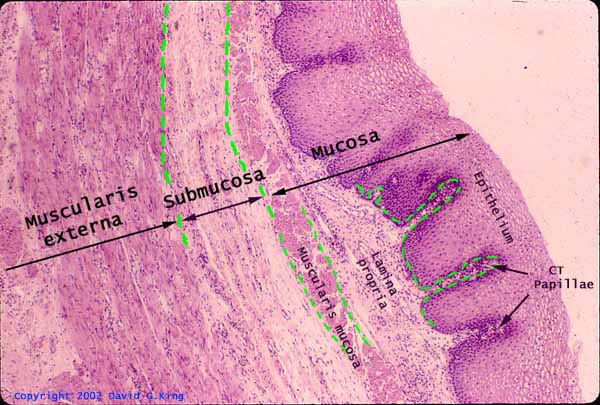

Esophagus, basic layers (cross section)

Notes
The basic layers of the GI tract are especially distinct in the esophagus.
In the esophageal mucosa --
Esophageal epithelium is non-keratinized stratified squamous. Note that the basal surface of the epithelium is deeply indented by connective tissue papillae.
In oblique section through the epithelium, the connective tissue papillae can look like "islands", apparently surrounded by epithelium. Beginning students frequently mistake such an appearance for glands.
Esophageal lamina propria is less cellular (fewer lymphocytes) than that in the stomach and intestine, presumably because the protective stratified squamous epithelium is more effective at keeping out foreign antigens. Nevertheless, lymph nodules may occur.
Esophageal muscularis mucosa is noticably thicker than that in the stomach and intestine, and includes only longitudinal muscle fibers.
Because the longitudinal fibers occur in bundles, a longitudinal section passing between bundles may not include any evidence of muscularis mucosae.
Connective tissue of the submucosa is typically more fibrous and less cellular than that the lamina propria of the mucosa. Esophageal submucosa includes scattered esophageal glands (not included in this micrograph, see this image) and a venous plexus (not conspicuous in this micrograph).
Muscularis externa of the esophagus consists of the standard inner circular and outer longitudinal layers of smooth muscle, with Auerbach's plexus in between. Only the circular muscle is included in this micrograph.

The vagina provides an instructive contrast with the esophagus. The vagina and the esophagus are both tubular organs with a mucosa lined by non-keratinized stratified squamous epithelium. Hence these two appear superficially similar. However, bundles of smooth muscle are interwoven with connective tissue throughout the wall of the vagina, so that there is no clear demarcation of submucosal and muscularis layers.
Certain special features which distinguish these organs (e.g., glycogen storage in vaginal epithelium, submucosal glands in the esophagus) are not always apparent in routine sections. So the difference between "layers distinct" and "layers not distinct" may be the easiest and most reliable way to distinguish these two organs (e.g., on a practical evaluation).
More esophagus examples:
Comments and questions: dgking@siu.edu
SIUC / School
of Medicine / Anatomy / David
King
https://histology.siu.edu/erg/GI005b.htm
Last updated: 27 May 2022 / dgk